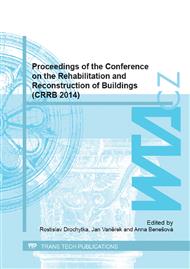p.3
p.7
p.11
p.15
p.19
p.23
p.31
p.35
Mineralization Influence on the Strength Parameter of Solid Wood
Abstract:
Moisture characteristics, related durability and especially strength parameters are observed for wood (solid, treated, or modified), which is used in building constructions. Material modification by siliceous substances reduces intake of liquid water, but solution exposition and subsequent deposition of mineral particles may also affect the physico - mechanical properties of the material. In this work, longitudinal compressive strength was determined for the samples treated by dipping in aqueous solution of organosilane. The results confirm the correlation between the length of dipping and the change of tested strength parameter.
Info:
Periodical:
Pages:
15-18
Citation:
Online since:
August 2015
Authors:
Price:
Сopyright:
© 2015 Trans Tech Publications Ltd. All Rights Reserved
Share:
Citation:


